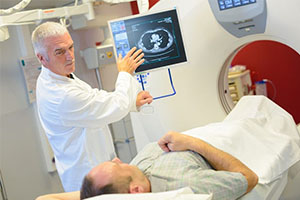MRI Guided Fusion: A targeted approach to detecting prostate cancer
Sep 19, 2022September is National Prostate Cancer Awareness Month, an important time to bring awareness to prostate health. The prostate gland is a male reproductive organ about the size of a ping-pong ball that produces semen. It is located between the bladder and urethra. As men age, abnormal prostate cells can begin to grow and the risk of getting prostate cancer goes up. According to the American Cancer Society, other than skin cancer, prostate cancer is the most common cancer in American men and the second leading cause of death for men, behind only lung cancer. While prostate cancer is rare in men under 40, about 60% of cases diagnosed are in men ages 65 or older and the average age at diagnosis is 66.
 Screening for prostate cancer
Screening for prostate cancer
Screening for prostate cancer is available. Early diagnosis can help prevent the disease from spreading and lead to treatment options. An elevated prostate-specific antigen level (PSA), determined by a blood test, is a common reason for a man to undergo a prostate biopsy. A prostate biopsy procedure retrieves prostate tissue suspected of cancer. The tissue is tested and reviewed by a pathologist under a microscope to determine if diseased cells are present. Prostate cancer diagnosis occurs after a biopsy procedure is tested and reviewed for the disease.
The seven board-certified urologists on staff at Palm Beach Gardens Medical Center are ready to serve the community with some of the latest treatment options in urology health. Palm Beach Gardens Medical Center offers advanced technology for urology care including targeted (MRI)/ultrasound fusion guided biopsies with robotic precision to detect and manage prostate cancer.
ARTEMIS 3D Semi-Robotic Prostate Fusion Biopsy System at Palm Beach Gardens Medical Center
With targeted MRI/ultrasound and the ARTEMIS 3D Semi-Robotic Prostate Fusion Biopsy System technology available at Palm Beach Gardens Medical Center, the urology team is able to better identify and more accurately biopsy suspicious prostate cancer areas. This urology care technology allows the urologist to use a specialized magnetic resonance imaging (MRI) scan with an ultrasound image to perform a prostate image guided fusion biopsy. The ProFuse Radiology Software technology includes an advanced imaging and computer-assisted detection tool for real-time analysis for multiparametric magnetic imaging (mpMRI) of the prostate. The system reports findings and preparation of MRI data for fusion on the ARTEMIS 3D Semi-Robotic Prostate Fusion Biopsy System.
During the biopsy, the urologist maneuvers the 3D semi-robotic arm with integrated electronic-mechanical tracking to scan, digitize and track the prostate in real time. The system’s 3D semi-robotic arm assists the urologist with navigation and precision throughout the biopsy. With the ability to switch between transrectal and transperineal modules, the urologist has flexibility to choose the preferred biopsy method to provide personalized treatment for each patient. The ARTEMIS 3D Semi-Robotic Prostate Fusion Biopsy System enables a high precision fusion as well as elimination of prostate deformation, real-time organ tracking and needle navigation during biopsy. Additionally, prior biopsies can be fused with the current plan and compared to either analyze or re-biopsy individual points.
Benefits of robotic prostate fusion biopsy
Prior to targeted MRI/ultrasound fusion guided biopsies, finding the location of cancer within the prostate gland could be challenging. Conventional TRUS prostate biopsy techniques could produce “blind biopsies” since urologists could not easily view the specific location of any abnormal tissue. Some benefits of the ARTEMIS 3D Semi-Robotic Prostate Fusion Biopsy System can include:
- Significant improvement in the accuracy of prostate biopsy
- Precise needle navigation to identified lesions
- Exact reproducing of treatment for analysis and re-biopsy
 Prostate cancer is survivable
Prostate cancer is survivable
According to the American Cancer Society (ACS), the 5-year survival rate for people with prostate cancer in the U.S. is over 98%. The ACS receives this information from the SEER (Surveillance, Epidemiology, and End Results) database, maintained by the National Cancer Institute (NCI), to provide survival statistics for different types of cancer. The SEER databases does not group cancers in stages (stage 1, stage 2, stage 3, etc.) instead, it groups cancers into local, regional and distant stages:
- Localized: There is no sign that the cancer has spread outside the prostate.
- Regional: The cancer has spread outside the prostate to nearby structures or lymph nodes.
- Distant: The cancer has spread to parts of the body farther from the prostate, such as the lungs, liver or bones.
The five-year relative survival rate for localized and regional prostate cancer is over 99%. However, if the disease is in the distant stage and spreads to other parts of the body, the five-year relative survival rate is only 31%. The good news is that with early screening detection and treatment, prostate cancer is survivable.

